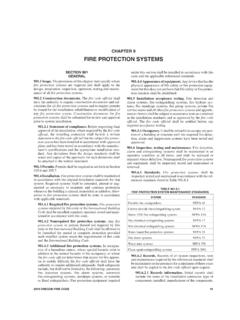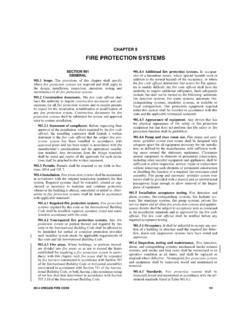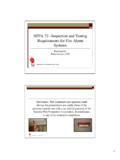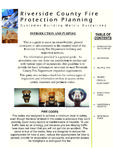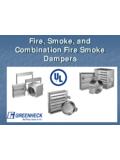Transcription of HSE Information Sheet 12/2007- Advice on …
1 HSE Information Sheet Advice on acceptance criteria for damaged passive fire protection (PFP) Coatings Offshore Information Sheet No. 12/2007 Additional PFP fire attack Establishing criteria for allowable damage to Coating damage, identification and Brief descriptions of damage, anomalies and maintenance Inspection, repairs and risk Relevant legal Further 1 Introduction This Information Sheet provides guidance for duty holders on better practice in understanding how typical anomalies in PFP coatings affect fire resistance performance. Repair of damaged PFP should be based on the assessment of damage in relation to the fire attack conditions. This guidance is based largely on the results of a Joint Industry Project that has examined the performance of cementitious and epoxy intumescent passive fire protection (PFP) coatings that contain anomalies. In this note, the role of fire protection is considered as part of maintaining Installation integrity or emergency response in the event of a fire , and does not include considerations for asset protection .
2 Background passive fire protection (PFP) is defined as a coating or cladding arrangement or free-standing system which, in the event of fire , will provide thermal protection to restrict the rate at which heat is transmitted to the object or area being protected. The type and amount of PFP needed depends on the fire type and duration and the failure criteria of the item being protected. The coating is a mitigation measure to protect items that have an identified role in maintaining structural integrity or platform emergency response, and will therefore have a Performance Standard associated with them. The coatings fire performance criteria specify survival times and fire type; hydrocarbon jet or pool fire and cellulosic fires. A review of the coating performance will be necessary if there are inherent defects in the application, deterioration through weathering or ageing or the PFP has been damaged .
3 Reappraisal of the PFP will need to consider if: It is still required and, if not, what to do with it? Old material is still sound but the original fire scenario has changed - can it be re-rated? A more severe fire scenario has been identified - what are the requirements? Some of the PFP has deteriorated or is damaged - what are the criteria for repair and how can it be repaired? passive fire protection (PFP) coatings are applied to barriers and structural elements of oil and gas installations to mitigate against the effects of fires (Ref 2). As such a Performance Standard (PS) will be associated with the coating. It will specify survival times and is aimed at ensuring an appropriate level of integrity of the protected item is maintained to prevent an event from escalating, or for ensuring that personnel can be evacuated safely during an emergency. The criteria are described by defining: Whether the protected item is a barrier or a load-bearing element.
4 The type of fire /heat flux loading to which it is subjected. The critical temperature that should not be exceeded to ensure integrity and/or insulation requirements are met. The time over which the temperature should remain below this critical temperature. 2 fire protection has three main aims: To prevent load-bearing structure reaching 400 C, the generally accepted temperature at which steel strength is reduced by half; To protect process vessels; To prevent heat transfer through walls into habitable spaces by limiting the inner wall temperatures (sometimes referred to as the back face) to an average 139 C and 180 C at any location. It is generally assumed in offshore safety case assessments (Ref 1, 2) that PFP material is fit-for-purpose, performs as specified, and therefore Performance Standards are met. However, there is evidence that PFP on some installations is not in acceptable condition, and OSD Inspections over a number of years have highlighted the variable state of PFP on these Installations.
5 Physical damage to PFP occurs constantly, as a matter of course, and in some instances protective coatings have been poorly applied and have degraded more rapidly than expected (Ref 3, 4 5) In recent years, several offshore Installations have changed their use and hence their fire attack profiles. Changes of this type may affect the platforms fire risks that then need to be re-assessed. Additional Information Coating materials form the majority of the PFP offshore as they can be applied to any shape. They comprise of three or four different layers, the primer coat (tie coat), the PFP (which will probably include some kind of mechanical retention system), a top sealer coat and / or a decorative topcoat. There are many types of passive fire protection coatings available, Cementitious (Mandolite), Epoxy Intumescent (Chartek IV), Subliming (Thermolag), Phenolic Foam (Firetex M89), Glass Fibre (Vosper Thornycroft GRP) and Elastomer Rubber (Viking fire Stop) all which can provide the required level of fire protection for different fire types.
6 The epoxy intumescent and subliming materials have the disadvantage that they begin to degrade at temperatures above 80 C and this precludes use on hot surfaces Separators. However, new dual layer systems have recently become available whereby phenolic foam is bonded directly to the hot surface, providing an insulating layer, and a second layer of material, with char forming components, is bonded to this. There are three fire categories against which PFP coatings are specified: A rating Cellulose fire , H rating - Hydrocarbon fire , and J rating- Jet fire . There is also a time component associated with the coatings fire rating viz. H60 rating provides protection in a hydrocarbon fire for 60 minutes. PFP fire attack characteristics When evaluating damage to PFP it is necessary to consider the fire type and conditions of flame and target interaction. An analysis of fire attack needs to be considered in terms of the thermal load on a component and possible erosive force of a flame.
7 For example, a 3 component fully engulfed in a flame will be subject to a higher heat load than a component only partly in contact with a flame. When dealing with Jet fires, the erosive effect of the flame has to be considered because it can cause significant damage to protective coatings particularly if the coating is not physically intact. Jet fires also have a higher heat flux than pool fires with the radiative and convective heat loads generated in different proportions. Jet fires therefore are more onerous in terms of mitigation than pool fires or a radiation heat load. Establishing criteria for allowable damage to coatings A significant finding of the tests on damaged PFP (Ref 6) is that anomalies in a protective coating are not acceptable. The tests confirmed the (fairly obvious) conclusion that some anomalies are more severe than others and highlighted the issue that some types of damage can cause gross failure of the PFP during a fire .
8 Additionally, that less significant damage, if left unrepaired, will deteriorate with time. The work also highlighted the very limited amount of useable data and Information with which to quantify anomalies in PFP. Hence describing damage to PFP coatings is essentially a qualitative process. The damaged PFP JIP (Ref 6) proposed that Qualitative categorisation is based on 3 severity levels. Severity Level 1 will cause gross failure of PFP, when subjected to a fire threat, leading to a significant element of the protected component becoming exposed to the fire . Remedial action will involve removal and reinstatement of significant amounts of material and should be undertaken immediately. This level of damage includes, Unretained and disbonded material Corrosion or mill scale under an epoxy intumescent Reinforcement exposed and visibly damaged Substrate exposed with reinforcement damaged Major failure of retention system at corners Water at PFP/substrate interface Waterlogged or popped material Modification with PFP not reinstated Addition of attachment with no PFP protection Severity Level 2 provides some protection of substrate but may reduce the fire resistance performance during the fire threat to a level that is unacceptable, or is present in an area of high structural importance, or presents a falling object or integrity hazard, or will lead to significant deterioration of the material.
9 Remedial action will involve a repair requiring reasonable levels of reinstatement within an agreed timescale. This includes, Retained but disbonded material PFP eroded with retention mesh exposed but intact Surface cracks, chips, gouges, scrapes, spalling and topcoat loss with reinforcement unexposed, but found in extreme environmental locations or areas of excessive physical exposure where accelerated 4 damage can occur. Any surface cracks, chips, gouges, scrapes and spalling with reinforcement unexposed but located on edge features of beams and columns. Evidence of inadequate material thickness or poor reinforcement at edge features of load bearing structural elements Any anomaly that is not a Level 1 anomaly but is located at a critical structural integrity location Evidence of chalking through exposure to UV (Intumescent). Evidence of heat damage from welded modifications or operations (Intumescent).
10 Part thickness anomalies at edge features of load bearing structural sections (Intumescent). Evidence of inadequate material thickness or poor reinforcement at edge features of load bearing structural elements (Intumescent). Severity Level 3 minor damage will worsen if not repaired but does not immediately reduce the fire resistance performance. It will lead to deterioration of the material leading to 1 or 2 unless corrected. Remedial action will be minor and will be a maintenance task. This includes, Surface cracks, chips, gouges, scrapes spalling and topcoat loss with reinforcement unexposed and located in protected environmental locations. Surface cracks, chips, gouges, scrapes and spalling with reinforcement unexposed but located in areas of extreme physical exposure. Coating damage, identification and evaluation A methodology for evaluating damage to protective fire coatings has been proposed (Ref 6) and should be used to evaluate the level of damage to a PFP coating in the context of the fire Hazard it is designed to mitigate.










